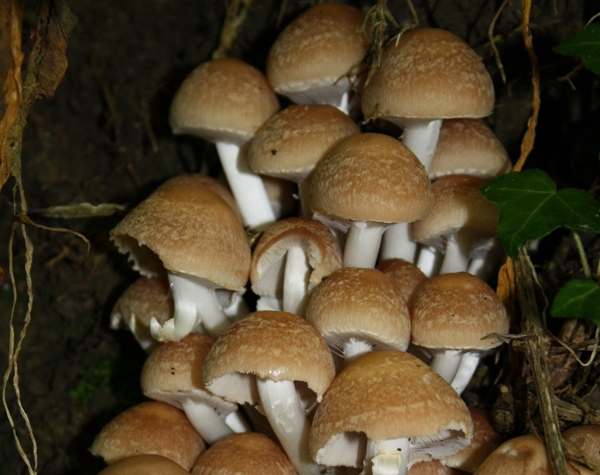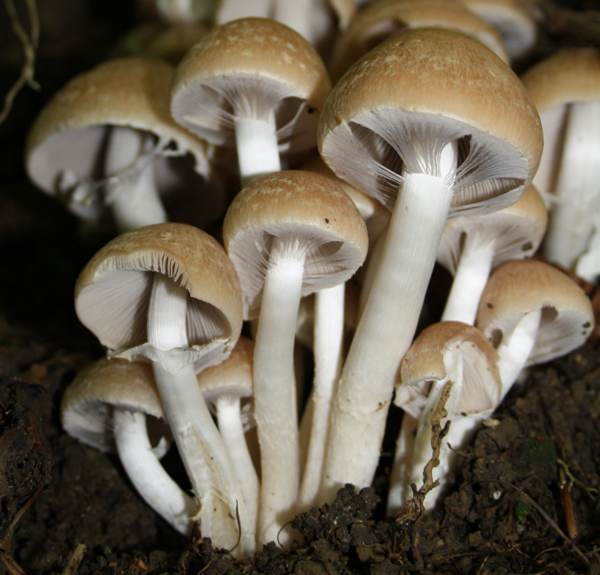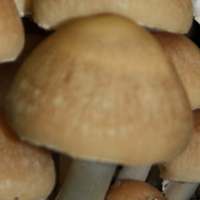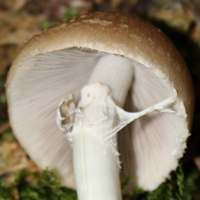Trees Birds Mammals Fish Amphibians Reptiles
Wild Algarve
Bookshop
Phylum: Basidiomycota - Class: Agaricomycetes - Order: Agaricales - Family: Psathyrellaceae
Distribution - Taxonomic History - Etymology - Identification - Culinary Notes - Reference Sources

Many of the so-called Brittlestem fungi (Psathyrella species) are saprotrophic on dead wood, and so woodlands or other places where there are rotting hardwood stumps or where dead timber lies just beneath the soil surface are the best places to look for them. Psathyrella leucotephra is an uncommon to rare find and usually occurs in tufts on or beside deciduous hardwood stumps or at the base of living Fraxinus (Ash) or Fagus (Beech) trees.
Distribution
Quite rare in Britain and Ireland, Psathyrella leucotephra occurs also in many parts of mainland Europe including Germany, France, Spain and Italy,

Taxonomic history
Psathyrella leucotephra was described scientifically in 1870 by English mycologists Miles Joseph Berkeley and Christopher Edmund Broome, who gave it the scientific name Agaricus leucotephra. It was British mycologist Peter Darbishire Orton (1916 - 2005) who, in 1960, redescribed this species as Psathyrella leucotephra, by which scientific name it is generally known today.
Synonyms of Psathyrella leucotephra include Agaricus leucotephra Berk. & Broome, Drosophila leucotephra (Berk. & Broome) Kühner & Romagn., and Hypholoma leucotephrum (Berk. & Broome) Sacc.
Etymology
Psathyrella, the genus name, is the diminutive form of Psathyra, which comes from the Greek word psathuros meaning friable; it is a reference to the crumbly nature of the caps, gills and stems of mushrooms in this genus. The specific epithet leucotephra comes from the Greek leukos, meaning white, and tephros, meaning ash-grey.
Identification guide

|
Cap
3 to 7cm across; initially convex, flattening; margin not significantly striate; hygrophanous, surface yellowish brown or pale brown when moist, becoming almost white when dry. The partial veil covers the gills on young specimens, and fragments can persist at the cap margin for some time after the veil fractures. |
 |
Gills
Adnate, fairly crowded; very pale buff initially, becoming grey then dark purple-brown but with white gill edges. Basidia are four spored. Cheilocystidia mainly langeniform (flask- or bottle shaped). Clamps are present.
Stem
8 to 12cm long; 4 to 8mm diameter, sometimes tapering slightly towards the apex; whitish, slightly flocculose below a superior pendent membranous stem ring. |
| |
Spores
Ellipsoidal, smooth, 7.5-10 x 5-6.5µm, with a germ pore.
Spore print
Purple-brown. |
Odour/taste |
Odour not distinctive; taste mild, floury. |
Habitat & Ecological role |
Saprophytic, occasionally solitary but much more often tufted, on decaying hardwood especially rotting stumps and roots in mixed woodland that includes Ash or Beech, apparently favouring areas where Dog's Mercury grows. In Britain most records are from Southern England and mostly from sites where the soil is calcareous. |
Season |
July to November in Britain and Ireland. |
Culinary Notes
This is not considered to be a good edble mushroom.
Reference Sources
Fascinated by Fungi, 2nd Edition, Pat O'Reilly 2016, reprinted by Coch-y-bonddu Books in 2022.
Dictionary of the Fungi; Paul M. Kirk, Paul F. Cannon, David W. Minter and J. A. Stalpers; CABI, 2008
Taxonomic history and synonym information on these pages is drawn from many sources but in particular from the British Mycological Society's GB Checklist of Fungi.
Top of page...
Fascinated by Fungi. Back by popular demand, Pat O'Reilly's best-selling 450-page hardback book is available now. The latest second edition was republished with a sparkling new cover design in September 2022 by Coch-y-Bonddu Books. Full details and copies are available from the publisher's online bookshop...